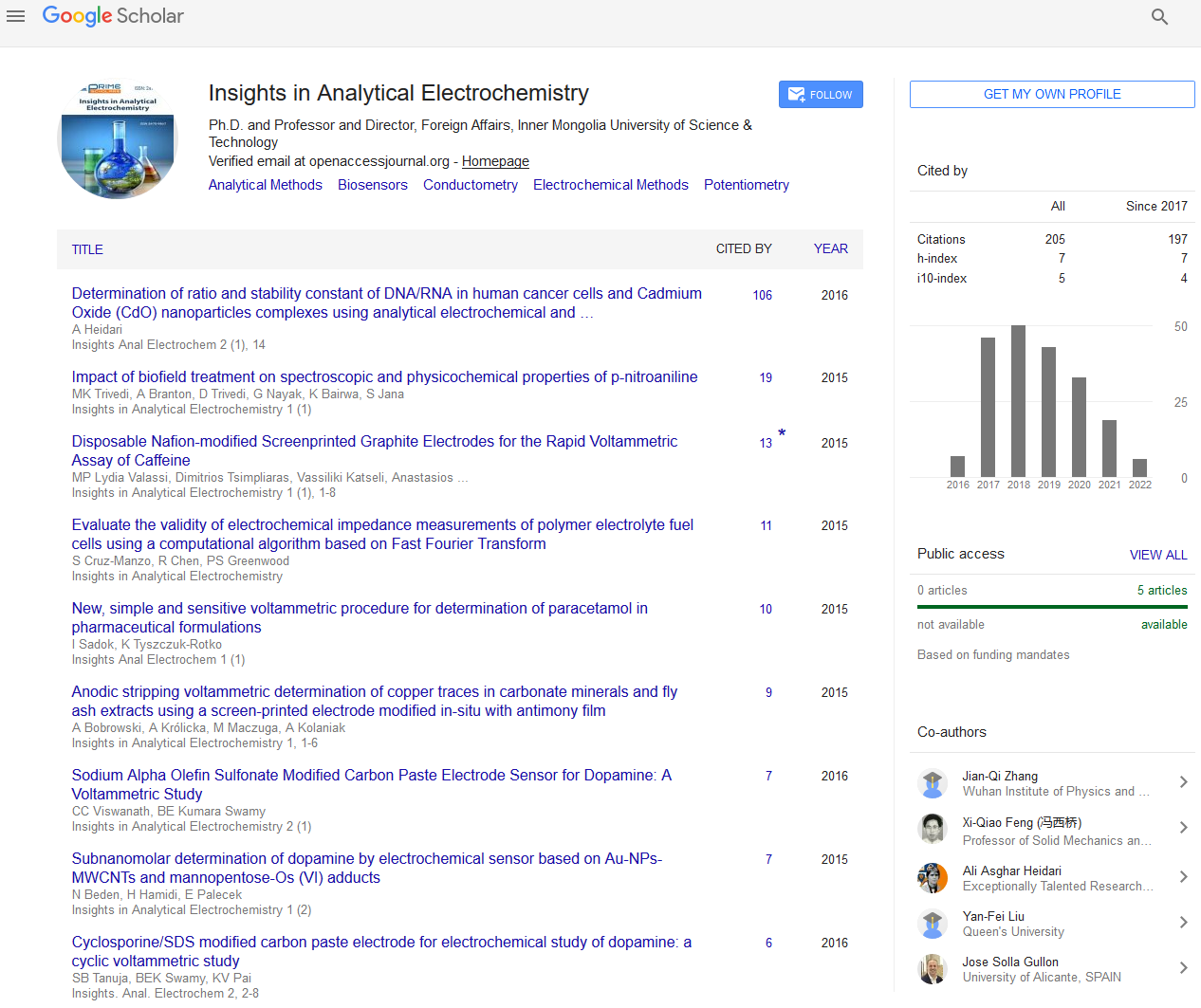Short Communication - (2023) Volume 9, Issue 1
Electrochemical Impedance Spectroscopy Utilized for the Investigation of Interfacial Properties
Jianbo Gao*
Department of Analytical Chemistry, University of Florida, USA
*Correspondence:
Jianbo Gao,
Department of Analytical Chemistry, University of Florida,
USA,
Email:
Received: 01-Mar-2023, Manuscript No. IPAEI-23-15943;
Editor assigned: 03-Mar-2023, Pre QC No. IPAEI-23-15943 (PQ);
Reviewed: 17-Mar-2023, QC No. IPAEI-23-15943;
Revised: 22-Mar-2023, Manuscript No. IPAEI-23-15943(R);
Published:
29-Mar-2023, DOI: 10.21767/2470-9867-9.1.06
Introduction
Electrochemical Impedance Spectroscopy (EIS) is a strong
method utilized for the investigation of interfacial properties
connected with bio-acknowledgment occasions happening at
the cathode surface, like immune response antigen acknowledgment,
substrate-chemical cooperation, or entire cell catching.
Consequently, EIS could be taken advantage of in a few
significant biomedical conclusion and natural applications.
Notwithstanding, the EIS is quite possibly of the most intricate
electrochemical strategy, hence, this survey presented the essential
ideas and the hypothetical foundation of the impedimetric
method alongside the cutting edge of the impedimetric
biosensors and the effect of nanomaterials on the EIS execution.
Description
Bioelectrical Impedance Spectroscopy (BIS) depends on an
electrical model got utilizing a wide band of recurrence. The
assurance of R at zero recurrence and at boundlessness recurrence
is utilized to anticipate extracellular compartment volume
and TBW, individually. Despite the fact that BIA and BIS
have exhibited a high relationship with direct assessment techniques
for TBW in support haemodialysis patients, BIS is by all
accounts more precise in evaluating liquid volumes. By the by,
BIS requires information on the patient’s weight, which isn’t
generally accessible in the ICU setting, as recently examined.
In a customary electrochemical cell, matter-(redox species)
cathode connections incorporate the grouping of electroactive
species, charge-move, and mass-move from the mass answer
for the terminal surface notwithstanding the obstruction of the
electrolyte. Every one of these highlights is described by an
electrical circuit that comprises of protections, capacitors, or
steady stage components that are associated in equal or in a series to frame a comparable circuit [1].
EIS has been one of the most well-known electrochemical discovery
approaches lately. At the point when the electrochemical
cathode framework is upset by an air conditioner sign of a
sine voltage (regularly <10 mV) or current, a relating current
or voltage reaction signal is produced from which the impedance
or conductance of the terminal can be gotten. Then, the
impedance range can likewise be determined from the unsettling
influence of sine signals at a progression of frequencies,
known as EIS. Because of the little plentifulness aggravation,
incredible effects on the framework are stayed away from, and
an estimated direct relationship is displayed between the unsettling
influence and the framework reactions, which makes
the information handling of the estimations clear. Reactions of
EIS can be utilized to reason the same circuit of the terminal,
by which the active interaction and excitation of the framework
can be examined. Active boundaries, for example, capacitances
of twofold electric layers, response protections of the charge
move cycle, and boundaries of the dissemination mass-move
process, can likewise be assessed by pertinent component values
in the same circuit [2-4].
Conclusion
A biosensor is an independent coordinated gadget in view of
a natural acknowledgment element(s) (e.g., proteins, nucleic
acids, antibodies microbes, lectins, cells) to give exact quantitative
or semi-quantitative scientific data. Among the most
well-known electrochemical biosensors, impedimetric biosensors
have drawn in a lot of consideration. Likewise, they have
been broadly taken advantage of to recognize enzymatic action,
DNA hybridization, immunizer antigen acknowledgment,
and restricting partiality. From our arranged data in this audit,
nanomaterials like metals, metal oxides, carbon, nanowires, nanocomposite, nanopores, nanochannels cluster, and nanogap
species have been utilized for creating EIS biosensors.
Acknowledgement
None.
Conflict Of Interest
The author’s declared that they have no conflict of interest.
References
- Ha LD, Park K, Chang BY, Hwang S (2019) Implementation of second-generation fourier transform electrochemical impedance spectroscopy with commercial potentiostat and application to time-resolved electrochemical impedance spectroscopy. Anal Chem. 91:14208–14213.
[Crossref] [Google Scholar] [PubMed]
- Fasmin F, Srinivasan R (2017) Review-nonlinear electrochemical impedance spectroscopy. J Electrochem Soc. 164:H443–H455.
[Crossref] [Google Scholar]
- Slouka C, Wurm D J, Brunauer G, Welzl-Wachter A, Spadiut O, et al. (2016) A novel application for low frequency electrochemical impedance spectroscopy as an online process monitoring tool for viable cell concentrations. Sensors. 16:1900.
[Crossref] [Google Scholar] [PubMed]
- Leva-Bueno J, Peyman SA, Millner PA (2020) A review on impedimetric immunosensors for pathogen and biomarker detection. Med Microbiol Immunol. 209:343–362.
[Crossref] [Google Scholar] [PubMed]
Citation: Gao J (2023) Electrochemical Impedance Spectroscopy Utilized for the Investigation of Interfacial Properties. Insights Anal Electrochem. 9:06.
Copyright: © 2023 Gao J. This is an open-access article distributed under the terms of the Creative Commons Attribution License, which permits unrestricted use, distribution, and reproduction in any medium, provided the original author and source are credited.

